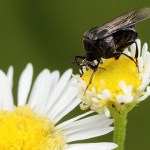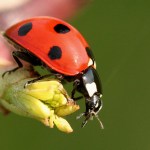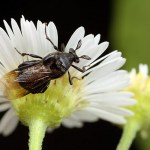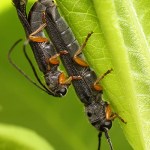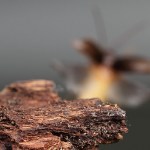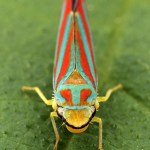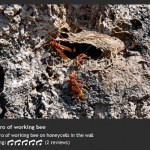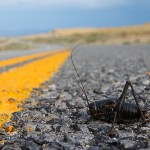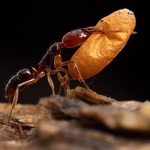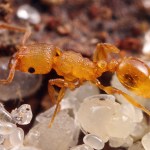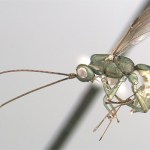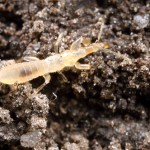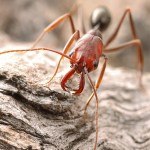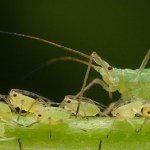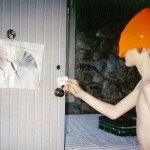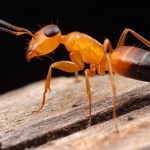insects
What was the strange insect that seemed a mutant cross between a bee and a beetle?
Rhipiphorus wedge-shaped beetle, ovipositing into an aster Shawnee National Forest, Illinois
Kudos and all 10 points go to coleopterist extraordinaire Ted MacRae of Beetles in the Bush, who provided the correct answer Coleoptera: Rhipiphoridae: Rhipiphorus .
Rhipiphorus is unusual for a beetle. Coleoptera counts few parasites among its hundreds of thousands of described species. But the wedge-shaped beetles are ectoparasites of bees. Adults can be found on flowers, laying eggs that hatch into little bee-…
If you could press your ear to a ladybird's chest, what would you hear? Not the steady thump thump of a human heart, but something quite different. Discovery News reports on work carried out by Igor Sokolov and his team at Clarkson University, who used an atomic force microscope to listen to the faint sounds emanating from inside living insects.
Listen to a ladybird
The researchers used this atomic stethoscope to record the internal sounds of other insects including a fly and a mosquito, which you can listen to here.
The work is published in Applied Physics Letters.
Tonight's challenge is this rather unusual insect.
What is it?
Points will be awarded to the first person to pick the order (3), family (3), and genus (3). Plus, a bonus point for explaining what is unusual about this insect's life cycle.
The cumulative winner for the month of June 2010 will get their choice of 1) any 8x10 print from my photo galleries; or 2) a guest post on the safe-for-work topic of their choice.
Yesterday afternoon, I watched the livestream of the "All Creatures Great and Smart" session of the World Science Festival in New York City. The session was absolutely fantastic, and featured Brian Hare, Vanessa Woods, Jeremy Niven, Patrick Hof and Klaus Zuberbühler.
The conversation challenged long-held assumptions about the differences between "animal" and "human", and included fascinating discussion about pin-sized brains that can count, categorize, and hold a grudge against those who've tried to swat them. Does your dog really think and feel like a human? Do our closest primate…
Oberea flavipes, phlox stem borer beetlesIllinois
Here's a boring beetle.
That is, the larvae bore. They make their living carving tunnels through stems and consuming plant tissue. This pair was hanging out in the phlox in our back yard, apparently plotting the demise of our summer flower garden.
photo details:
Canon EOS 7D camera
Canon MP-E 65mm 1-5x macro lens
ISO 100, f/13, 1/250sec
diffused twin flash
Thanks to Rob Mitchell for the ID.
The bold, playful style of Graphocephala coccinea, the candy-striped leafhopper, is all the rage this season:
photo details:
Canon EOS 7D camera
Canon MP-E 65mm 1-5x macro lens
ISO 100, f/13, 1/250sec
diffused twin flash
Speed was essential to scoring points in yesterday's istockphoto taxonomy fail challenge. Commentator JasonC replied within minutes of the original posting with 8 answers correct to the appropriate level and is awarded 8 points. RobM and MarekB also picked up a point each for adding identifications of the Syrphid and the fire ant male.
Correct answers were considered those that identified the mystery insects to the same taxonomic level as the original iStockphoto misidentification:
Red Admiral
Robber Fly
Hemiptera
Crane Fly
Katydid
Cuckoo Wasp
Hornet (Vespa)
Drone Fly (Eristalis)
Sugar Ants…
With plumes of crude oil destroying the Gulf of Mexico, tensions rising in the middle east, a severe hurricane season reving up in the Atlantic, and the earth opening up and just plain swallowing parts of Guatemala City whole, what else could possibly go wrong?
A mormon cricket crosses the road, Nevada.
Well. How about a plague of locusts?*
The USDA has just announced that the conditions are ripe for a grasshopper outbreak in the northern great plains:
The U.S. Department of Agriculture's Animal and Plant Health Inspection Service (APHIS) is expecting potentially heavy grasshopper outbreaks…
Mystery #1
I admit, I like to pick on iStockphoto, the pioneering company behind the high volume/low cost microstock model of media licensing.
There's nothing wrong with microstock. After all, the thriving web-based market for cheap images is a ripe opportunity. But buyers get what they pay for, and they should be aware that a photographer who nets forty cents an image is unlikely to fact-check with the same level of rigor as one paid $400 an image. So the microstocks are entertainingly peppered with error.
Tonight's challenge: put a name on each of these ten taxonomic disasters from the…
Anochetus paripungens trap-jaw ant carrying a cocoon, Australia
photo details:
Canon EOS 50D camera
Canon MP-E 65mm 1-5x macro lens
ISO 100, f/13, 1/250sec
twin flash heads placed in front and behind the subject.
You folks are quick. Not two minutes after I posted yesterday's mystery bug, commentator FormicidaeFantasy provided the correct answer: it is the forelimb of a praying mantis. Specifically, a nymph of the Carolina mantis Stagmomantis carolina.
So, eight highly valuable Myrmecos Points go to FormicidaeFantasy. A number of you chimed in with additional relevant information. A point each for Chris Grinter, Christopher Taylor, James Trager, Tim Eisele, and Peter Coffey.
We haven't done an ant mystery for ages. So here you go:
Although I photographed this little ant in Florida, it could just as easily have been in a number of tropical places.
Five points each for the first person to pick the genus and the species.
The cumulative points winner for the month of May will win either 1) any 8x10 print from my insect photo galleries, or 2) a guest blog post on the (safe-for-work) topic of their choosing.
Heterospilus, undescribed species, Costa Rica
My more astute readers may have noticed that Myrmecos Blog has been uncharacteristically quiet this week. I do apologize, but I have a regular research job aside from blogging that periodically requires attention.
I've been assembling genetic and morphological data from 100 or so wasps in the hyperdiverse genus Heterospilus. These are small insects, typically under a centimenter in length, that attack stem-boring grubs like beetle and moth larvae. This week I am patching up the holes in the molecular data matrix, and this requires bench time…
What was the mystery?
It's a unique-headed bug in the enigmatic family Enicocephalidae. These soil-dwelling insects are predators of other arthropods. They are of phylogenetic interest as a potential sister lineage to the remaining Heteroptera, the true bugs.
Enicocephalids aren't terribly common- I can count on one hand the times I've seen them in the field- and I was most surprised to find one scurrying about under a stone in my small urban front yard.
Five points to James Trager, who first picked the order. And five more to Kojun, who got the family.
...because badass mandibles are in style this season:
Odontomachus turneri, Australia
photo details:
Canon EOS 50D camera
Canon MP-E 65mm 1-5x macro lens
ISO 100, f/13, 1/250sec
A: If, at birthday parties, the featured game is "pin-the-stinger-on-the-bee."
your intrepid blogger, circa 1985
You may thank my mother for sending along this, um, interesting photo.
New this week at alexanderwild.com we have photographs of the Savanna Strobe Ant Opisthopsis haddoni. These delightfully perky insects inhabit open environments in northern Australia and are one of my favorite ants.
Opisthopsis has excellent vision. The location of the compound eyes atop the head allows it to spot a photographer approaching from any direction and take appropriate evasive action. This wasn't the easiest ant to shoot.
The peculiarly erratic style of walking is also not conducive to photography. The common name "strobe ant" refers to this ant's unpredictable little fits and…
